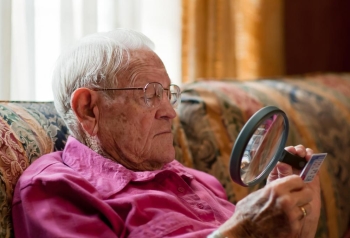Age-related macular degeneration (AMD) is an eye disease that can blur the sharp, central vision you need for activities like reading and driving. "Age-related" means that it often happens in older people. "Macular" means it affects a part of your eye called the macula.
Macular degeneration does not cause complete blindness by itself. It can, however, interfere with daily activities such as driving, writing, reading, cooking, or even recognizing faces. It can be debilitating, and there is no cure-although there are treatments that can mitigate the effect.
What causes age-related macular degeneration?
The exact cause of AMD is not known, but it has been linked to a number of risk factors. These include having excess weight and high blood pressure, smoking, and having a family history of the condition.
Wet vs. Dry
Dry macular degeneration is the most common, and is usually how the disease starts. Approximately 80-90% of cases are dry. In this type of degeneration, white and yellow deposits or "drusen" are found on the retina under the macula, causing damage over time. In the most severe cases, dry macular degeneration causes a thinning in the macula's normal, healthy cell layers, resulting in atrophy that can cause blind spots in the patient's central field of vision.
Wet macular degeneration is more serious. While it affects only about 10-15% of cases, it is also the culprit in about 90% of the most severe cases of vision loss from macular degeneration overall. It occurs when abnormal blood vessels grow in the area of the macula. The blood vessels leak, break, and bleed frequently, causing serious damage to the macula that eventually separates it from the rest of the eye.
It is possible to have the wet form of the disease in one eye, and the dry form in the other. Those who are most at risk for developing macular degeneration are the elderly. Most cases appear in patients age 60 years or older. It is possible to contract it at a younger age, however.
Treatments include:
Medications. The most common are the anti-angiogenesis drugs that stop new blood vessels from forming under the macula, and help prevent abnormal vessels already there from leaking. These drugs are a major leap forward for treatment of wet macular degeneration, and they can even cause vision to return in some cases. These drugs are often administered via injection, on a monthly or six-week basis, or on a different timeline depending on the patient's needs.
Vitamins can also be helpful. Vitamins C, E, copper, zinc, and beta-carotene have all been shown to help slow the progress of dry macular degeneration.
Laser treatment. Laser light therapy can destroy abnormal blood vessels under the macula, stopping them from growing and damaging the tissue.
A joint medication and laser light therapy technique called photodynamic laser therapy has also been shown to be effective. With this treatment, a light-sensitive drug is injected into the patient's bloodstream, where it enters the blood vessels under the macula. Afterward, the doctor shines a laser into the eye, activating the drug and destroying abnormal blood vessels.
Vision aid devices. Some devices with specially designed lenses or electronic features that show magnified images of nearby objects have also been shown to help patients with this type of degeneration see better.
There are other types of treatment as well, which are considered to be more experimental. These include submacular surgery and retinal translocation to eradicate abnormal blood vessels. Patients do not go blind from macular degeneration, and although the disease can cause impairment, it is also possible to live a normal life with it-especially with the assistance of vision aids and treatment.
While there is no cure, several different types of treatments have been shown to help slow the progress of the disease and even improve the patient's vision.
Healthy Aging and Your Vision:
More than 40 million Americans are
currently age 65 or older, and this number is expected to grow to
more than 88 million by 2050. By that same year, the number of
Americans with age-related eye diseases is expected to double, and
the number of people living with low vision is projected to triple.
While vision loss is not a normal part of aging, older adults
are at a higher risk for certain eye diseases and conditions,
including:
- Age-Related Macular Degeneration
- Cataracts
- Diabetic Retinopathy
- Glaucoma
- Dry Eye
- Low Vision
Eye diseases often have no early symptoms but can be detected during a comprehensive dilated eye exam. Early detection and treatment are key to saving sight.
To learn more about healthy aging and vision, visit the
National Eye
Institute (NEI) or visit the Healthy Aging®
website at healthyaging.net
to access a variety of lifestyle resources and content.
Related Articles About Healthy Aging:
Home | About | Articles | Resources | Site Map | Privacy Policy
Elder Options of Texas
Copyright 2001-2024
All Rights Reserved
DISCLAIMER: Links to other websites or references to products, services or publications do not imply the endorsement or approval of such websites, products, services or publications by Elder Options of Texas. The determination of the need for senior care services and the choice of a facility is an extremely important decision. Please make your own independent investigation.


